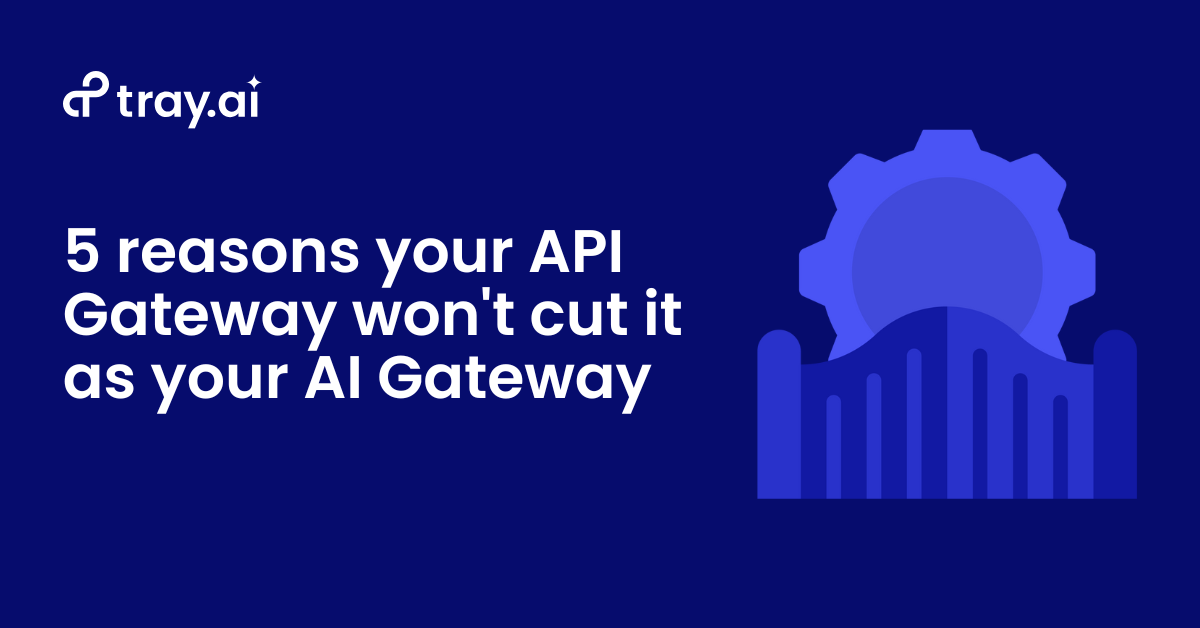5 reasons your API Gateway won't cut it as your AI Gateway


Austin Johnson
AI is transforming businesses at breakneck speed, but your API gateway could be the bottleneck holding you back. Learn the five critical reasons enterprises need AI Gateways to deliver AI projects faster.
Imagine this: According to Gartner's 2024 research, 46% of organizations cite data accuracy and transparency as their top AI implementation challenge, while 39% struggle with data protection. Your organization has just given the green light to a major AI initiative, following industry leaders like L'Oréal, who launched their 'GenAI as a Service' in just three months using Google Cloud Run and LangChain. As the IT leader, you're confident your trusty API Gateway can handle it. But should you be?
API Gateways have long orchestrated digital transformations, but the AI era is rewriting the rulebook. AI workloads aren't just another API call – they're a different beast entirely, with unique demands in processing, security and management. Enter the AI Gateway: your API Gateway's sophisticated cousin, purpose-built for large-scale AI deployments.
Let’s explore five critical reasons why your organization’s API Gateway might fall short in AI governance:
1. Insufficient cost management for AI workloads
Traditional API cost tracking (e.g., X calls = Y cost) falls short for AI services. Standard gateways can't track token-based pricing (used by most LLM providers), leading to:
Unpredictable costs and inefficient resource allocation
Missed opportunities for cost reduction through prompt optimization
Limited visibility into department-specific AI usage
Consider Snapchat's experience: Their cloud infrastructure cost per daily active user jumped from $0.59 to $0.85 due to AI investments, impacting 422 million daily users. Even with sophisticated infrastructure, they needed specialized tools to optimize these costs, ultimately reducing per-user costs back to $0.80 through improved engineering efficiency and pricing optimization.
AI Gateways provide granular cost tracking and allocation so organizations can fully understand and control AI resource usage. With platforms that offer detailed insights into token-based pricing, organizations can make informed decisions about model usage, optimize prompts, and allocate costs effectively. An AI-ready iPaaS plays a crucial role in simplifying and automating these processes, ensuring scalability and cost efficiency.
2. Lack of AI-specific security measures
While API Gateways handle traditional web security, AI systems introduce new challenges. Consider JPMorgan Chase's journey: They initially banned ChatGPT over data security concerns, but later developed their own AI assistant solution, LLM Suite, to safely deploy AI to over 60,000 employees. As their Chief Data Analytics officer noted, "Since our data is a key differentiator, we don't want it being used to train the model... We've implemented it in a way that we can leverage the model while still keeping our data protected.”
However, data privacy isn’t the only challenge introduced by AI systems. There’s also:
Prompt injection attacks: Sophisticated attempts to manipulate AI outputs by crafting malicious inputs
Model theft: Protecting proprietary AI models from reverse-engineering attempts through careful output monitoring
Output safety: Implementing content filtering to avoid generating harmful, biased, or inappropriate content
A dedicated AI Gateway integrates tailored security measures that address these vulnerabilities, offering features such as output monitoring, encryption, and role-based access control. By leveraging an AI-ready iPaaS, organizations can establish safe and compliant AI environments that protect sensitive data while scaling responsibly.
3. Inability to optimize AI model selection
AI workloads require nuanced request routing based on task complexity, response time needs, cost considerations, and user context.
Take Spotify's recommendation system: They employ multiple AI models and algorithms, each optimized for specific tasks - from audio analysis to natural language processing. Their success stems from intelligent routing that matches requests to the most appropriate model based on context, something traditional API Gateways simply weren't designed to handle.
Standard gateways' limitations lead to:
Resource wastage: Overusing powerful models for simple tasks, increasing costs unnecessarily
Poor user experience: Slower responses due to inefficient selection, or inconsistent results across similar requests
Missed optimization opportunities: Inability to fine-tune based on real-world data and evolving use cases
AI Gateways can intelligently route requests to the most appropriate model based on complex criteria, even dynamically switching between models mid-conversation for optimal performance and cost-efficiency. This precision prevents resource wastage, ensures faster response times, and provides a seamless user experience – all critical for organizations aiming to deliver fast, safe, and flexible AI projects.
And on top of this, without the right level of observability, how are you going to make bold claims (and wow your investors) like Morgan Stanley, whose AskResearchGPT showed "salespeople taking 10% less time to respond to client enquiries"?
4. Limited observability for AI-specific metrics
Traditional gateways can't provide insights into crucial AI metrics such as:
Model performance: Accuracy, precision, recall, F1 scores across different types of requests
Inference time and token usage: Detailed breakdowns by model, request type, and user segment
Model drift: Detecting changes in model performance over time that may require retraining or adjustments
Prompt efficiency: Analysing which prompts yield the best results for specific use cases
Well-designed AI Gateways should offer deep observability into these AI-specific metrics, enabling proactive optimization and troubleshooting of AI systems at scale. While observability is key for effective oversight, it also lets teams continuously improve their AI initiatives with data-driven adjustments. An AI-ready iPaaS enhances this observability so teams can unlock even deeper insights and optimize workflows at scale.
5. Insufficient content filtering and output control
Duolingo's implementation of GPT-4 showcases the importance of sophisticated content filtering. They deployed AI routines specifically to ensure conversations stay on-task and appropriate, using multiple AI models working together to monitor and steer interaction.
However, traditional API Gateways weren't designed to handle the nuanced content management needs of AI systems. They lack:
Output moderation: Built-in capabilities to filter inappropriate, biased, or harmful content in real-time
Context-aware filtering: The ability to evaluate responses based on user roles, department policies, or industry regulations
Dynamic content policies: such as support for adjusting filtering rules based on use case or audience context
AI Gateways incorporate sophisticated content filtering mechanisms that automatically screen outputs for sensitive information, inappropriate content, and potential compliance violations. They may further enforce role-based content policies that align with organizational guidelines, and provide detailed audit logs of content decisions for compliance and governance purposes.
Enabling scalable AI projects
AI Gateways are designed to handle the above scenarios efficiently, providing the foundation for responsive, scalable AI applications that can handle enterprise workloads. As AI becomes central to business operations, specialized AI Gateways are crucial for governance, security, and cost management. They provide the nuanced control and insights needed to harness AI's full potential at enterprise scale.
As we navigate the complexities of enterprise AI implementation, many organizations are grappling with similar challenges. That’s why the team at Tray have been exploring practical solutions that benefit the wider IT community.
For our team, it made sense to start by leveraging tools we already had at hand. After all, for any AI strategy to be effective, it must seamlessly integrate with existing data and systems. Whether that's pulling insights from LLMs, refining models with enterprise data, or building RAG systems with custom knowledge bases — the integration piece is crucial.
That's why we developed a quick POC using the Tray platform, an AI-ready iPaaS, to demonstrate a pragmatic approach to AI Gateway implementation. It addresses many of the challenges discussed in this post, offering insights into how organizations might begin to tackle these issues.
AI-ready platforms let organizations accelerate timelines by automating repetitive tasks, optimizing workflows, and ensuring AI systems deliver consistent, reliable outputs. Enterprises can then focus on innovation rather than wrestling with operational bottlenecks.
Ready to see what’s possible? Discover how an AI-ready iPaaS lets you accelerate your AI initiatives in a safe and flexible way.